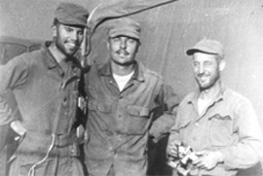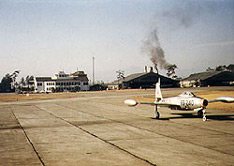| After being recalled to active duty as a USAF pilot in the spring of 1951, and a tour of duty as an advanced twin-engined flight instructor at Reese AFB, Lubbock, Texas, I found myself reassigned to Randolph AFB, San Antonio, Texas, for B-29 combat crew training. The USAF Air Training Command had a pipeline program that had been training and shipping replacement B-29 aircrew to the Far East in support of the Korean War effort since the early stages of that conflict.
After settling my wife and children in temporary housing in New Braunfels, Texas, I checked in at the Randolph training facility, joining others who were destined for B-29 crew training and shipment to either Okinawa or Japan for combat mission service. One of the first bits of news we received was that all B-29s on the field were grounded, temporarily, due to depot replacement engine overhall defects. We were to be academically trained and shipped out for flight training elsewhere.
By the time we had completed the academic training program, I learned they had enough good engines on hand to provide flight training to at least one crew. Locating the Master Sergeant, whose duty it was to form the crew rosters, I got his agreement that if I could identify a full crew of volunteers for overseas duty from their resource list of available trainees, we could become “that crew”. It didn’t take long to find a full crew of volunteers and we were soon involved in the flight training program.
Before continuing, I would like to introduce you to our crew.
|

|
Top, L to R: Robert D. Barnhart, SD, Radio Operator; James B. Cliver, TX, Flight Engineer; William M. Steiner, AL, Camera Operator; Ronald J. Glowcheski, WI, Scanner-Gunner WI; Robert H. Weisburn, OH Photo Navigator; Samuel E. Farley, KS, Tail Gunner.
Bottom, L to R: Charles A. Stone, MN, Aircraft Commander; Merle Hahn, MN, Pilot; Richard J. Sniker, MN, Central Fire Control Gunner; Fred K. Brackbill, PA; Navigator; Donald E. Kleinkauf, NE, Scanner-Gunner; Paul A. Jackson, LA, Radar Navigator.
Our training progressed, on schedule, with a bit of excitement now and then. During transition training, while shooting touch-and-go landings, we developed a fuel leak in one of the engines, causing the aircraft to fill with gas fumes, threatening a full scale explosion. Quick ventilation action by the Instructor Pilot, complete electrical shutdown, permitted a safe landing. On one occasion we had a single engine failure and on another, two engines progressively failed (this time at night). We returned safely and soon thereafter completed this phase of our training. After flying our first Bombardment combat crew training missions, we were switched to Reconnaissance Training, destined to join the 91st Strategic Reconnaissance Squadron at Yokota Air Base, Japan.
Saying goodbye to Randolph, we had a short leave to settle family affairs and were soon on our way to Stead AFB for Survival Training. After a couple of weeks of being starved, harassed and educated, they sent us on to our point of departure from the US for airlift, via a C-54 Transport, destined for Tokyo, Japan.
|

|
Here are three of our crewmembers, after the escape and evasion exercise, and an extended hike through the mountains on the California - Nevada border — From the left: Fred Brackbill, Chuck Stone and Bob Weisburn. As Aircraft Commander (Chuck), I took special pains to prepare our crew for the escape and evasion exercise and ended up being the only one captured on the sneak-through of the enemy lines to safety.
|
The penalty for that error was to be stripped naked, interrogated and thrown into the prison compound until the new day was well started. To my good fortune, our crew welcomed me back into the fold with warmth and gracious good humor.
|
| Our USAF C-54 transport trip to the Far East was a pleasant and sociable experience, with refueling stops in Hawaii and Wake Island. We landed at Tokyo International, were met by Yokota transportation office personnel, and bussed to our new operational base.
Our first night was spent in second floor quarters, located above the Yokota base operations lobby. You see the building in the left rear of this picture, taken later from the #1 position to the runway for takeoff. Note that the F-84 taxiing out was given the right-of-way to preserve his precious fuel supply.
End of Crew Introductions.
|

|
PREVIOUS — CONTENTS PAGE — NEXT
|
Home - Contact Us - Cold War Hist. - 91st SRS Hist. - Stardust 40 Mission Story
RB-29 Crew Hist. - Hiking Rural Japan - Extended Stories - Short Stories
Biographical Notes - Current Commentary - Art Gallery - Fun Stuff - Education
Programs - Locator- Reunions - Memorials - Cold War Museum Web Site
|
|
|


